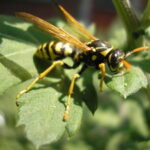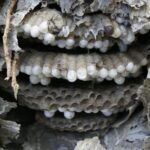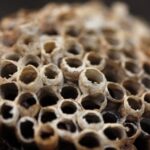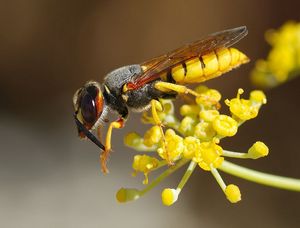Removing a wasp nest can be an intimidating task. If it seems to scary then there are pest removal companies that can be hired to do it for you. Also, if you have an allergy to wasp stings it is a good idea to avoid removing wasp nests yourself. If you do decided to remove them yourself it is important to have the information needed to do it the right and safe way.
Paper wasps, hornets and yellowjackets are all types of wasps. You can usually identify the type of wasp by the location of the nests. Paper wasps are usually the ones you want to remove because they are nest under eaves, porches, piers, barns and other places that bring them in close contact with humans. Luckily paper wasps are also the least aggressive wasps and so are the safest nests to remove. Yellowjackets tend to next underground and are the ones that tend to attack you while you are mowing or do other yard work. Rarely they will also nest in wall voids of home. Hornets are actually black and white yellowjackets. They tend to nest high in trees so removing their nests is rarely necessary.
It is recommended to remove wasp nests at night when the wasps are sluggish and slow. You can use a pesticide or not depending on your preferences. The method differs based on your choice.
Removal by use of pesticides.
First purchase a wasp poison meant for the purpose of wasp nest removal such as Wasp Freeze. It will kill the wasps immediately but will not remain on the nest to kill individuals that return to the nest. If you spray the nest at night it ensures that the majority of the population will be present in the nest. Once the wasps are dead it is a good idea to knock the nests down. Nests are not reused each year however pests such as the carpet beetle often will use the old wasp nest and then invade and infests your home.
Removal by hand.
First of all never burn or flood a wasp nest as this will only anger the insects. Before removing wasp nests you should be appropriately attired. Wear protective clothing. Some suggestions are wearing several layers of pants and long sleeved shirts and also gloves. Taping the cuffs can keep wasps from flying into your clothes. It is also recommended to have an assistant similarly dressed to help you with your wasp nest removal. For an aerial nest (a nest hanging from a tree, porch, eaves, etc) you’ll need a cloth bag. Slip the bag quickly and completely over the nest, detaching the nest from where it hangs and tying the bag shut as quickly as possible. You then place the bag in water and keep it completely under the water for several days allowing all the wasps to die. Nests on the ground should be covered with a large, clear bowl. Be sure that all entries to the nest are covered by the bowl then push the bowl into the soil sealing off all the exits. Leave the bowl there for several weeks and the wasps will all die. If you have nests underground or in walls that need to be removed it is necessary to hire a professional in order to not drive the wasps deeper underground or further into the walls.
Preventing wasp nests.
Wasp prevention requires pesticides. To prevent wasps you’ll need a long term insecticide spray. A spray specifically designed for wasps with a long residual period will work best. There are ones that are safe for family, children and pets. If you purchase a good spray then monthly spraying will not be necessary. You may only have to spray 2 to 4 times a year. Spray the insecticide on eaves, door trim, window sills and anywhere else that you often get nests or that you think the wasps may make nests in the future.
Resources:
http://www.ineed2know.org/wasps.htm
http://www.pestproducts.com/paper_wasps.htm





